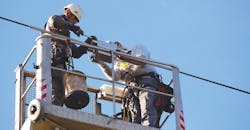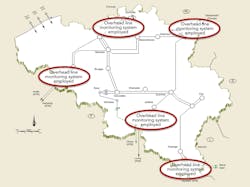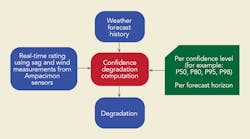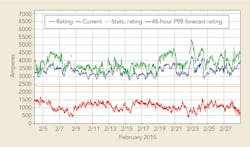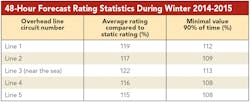Dynamic Ratings Increase Efficiency
The development of large renewable energy sources has created the need for important changes in the management of transmission grids and distribution networks. Power flows are more volatile and intermittent, which increases the need for information about transmission system capacity while reducing the overhead line usage factor (megawatt-hour transmitted per megawatt of transmission/distribution capacity).
The strategy to build new overhead transmission lines or upgrade and reconductor them requires huge investments and time to become fully operational. The last 10-year network development plan of the European Network of Transmission System Operators for Electricity (ENSTO-E) estimated transmission required an investment of 150 billion euros (US$161.8 billion) to support the ambitious European renewable energy scenario. Therefore, it has become mandatory to develop new approaches to increase the efficiency of the existing transmission system assets in a secure manner to deliver the required capacity in accordance with a timely and economically viable plan.
In Western Europe, the integrated electricity market is now a reality. The power flows, however, are limited by the cross-border transmission system capacity between the interconnected countries. In 2012, Western Europe congestion costs for interconnections reached 1.2 billion euros (US$1.3 billion).
One solution to increase network efficiency is dynamic line rating (DLR). By monitoring existing transmission system assets in real time, transmission system operators (TSOs) and distribution network operators can significantly increase overhead line ratings from the existing conventional ratings, which are usually static and vary with seasons.
Belgian Grid Situation
The winter peak demand on the Belgian system is around 13,000 MW. The loss of three 1000-MW nuclear power plants in the summer of 2014 highlighted the potential risk of power shortages during the winter, in the event of severe weather conditions. Belgium imports electricity from neighboring countries through transmission system interconnectors, but the maximum import capacity — based on traditional seasonal rating of the transmission lines crossing the Belgium border — would be insufficient to supply any shortfall because of adverse winter weather conditions.
Belgium’s TSO, Elia, was familiar with the potential benefits of adopting DLR, having installed Ampacimon technology on several domestic overhead lines in 2011. Therefore, to maximize imports in real time and to reduce the risk of load shedding during the 2014-2015 winter, Elia decided to implement DLR on all the critical overhead line transmission interconnectors with France and the Netherlands.
Adopted Solution
Belgium has 10 cross-border interconnectors — six overhead lines with France and four overhead lines with the Netherlands. Elia decided to equip the eight most critical interconnectors with DLR and awarded a contract to Ampacimon for real-time sensors and forecast monitoring software. For the interconnectors where the overhead line conductors were different on each side of the border, the load-transfer capability of the interconnector was always significantly lower on the Belgian side. Hence, the first immediate solution was to equip only the Belgian side.
In agreement with neighboring TSOs — RTE in France and TenneT B.V. in the Netherlands — it was decided to operate the cross-border transmission lines using two limits, namely a dynamic limit for the Belgian side and a static limit for the other side of the border. For each cross-border overhead line, the load-transfer capacity is calculated as the minimum of the dynamic and static limits. The Ampacimon sensors measure the span sag and perpendicular wind speed. Based on sag and wind speed, the real-time rating is computed for each span as well as the complete line. A short-term forecast is computed for the first hour and the following four hours. These forecast ratings are transferred to Elia’s supervisory control and data acquisition (SCADA) system every five minutes.
For operations purposes, it is necessary to establish a stable value for an hour to enable calculations for the grid-security assessment and to give control staff sufficient time to react to possible incidents. The N-1 calculations are performed automatically every 15 minutes using the one-hour forecast rating instead of the seasonal rating.
Thermal ratings (wind cooling) can provide increases of more than 200% of the seasonal rating, but other transmission system assets (for example, transformers and circuit breakers) have lower ratings. The rule applied for Belgian lines limits the gain generated by the dynamic rating to 130% of the seasonal rating. However, if any transmission system asset in the circuit is not designed to withstand a 130% rating capability — the maximum line rating — it is limited accordingly.
This fully automated process enables integration of the real-time measurements from the sensors up to the grid-security assessment without the intervention of control center staff.
Two-Days-Ahead Method
Days-ahead rating forecasts require weather data beyond a horizon of about six hours, so it is not possible to use the time-series forecast method. Weather-based rating forecasts provide the trend of the real-time rating for the following days, but fail to give reliable rating forecasts, mainly because of uncertainties in wind-speed forecasts, in particular for wind speeds whose perpendicular component to the conductor axis is lower than 2 m/sec to 3 m/sec (6.6 ft/sec to 9.8 ft/sec).
In climatology, high wind speeds — typically measured by weather stations above 5 m/s (16.4 ft/sec) at 10 m (32.8 ft) high — are related to macro-scale effects, but low wind speeds mainly result from local effects generally related to the local topology and screenings such as trees, buildings and terrain roughness, which cause conductor-level turbulence.
As the main concern of TSOs is the overall management of risk, a guaranteed rating forecast should be determined so the TSO may use it in operational practice. To ensure secure operation of the grid, days-ahead rating forecasts must be extremely reliable — that is, with a high confidence level, at least 98% — as is the case for conventional seasonal, static ratings. In practice, ambient temperature can be forecasted accurately and maximum sun radiation can be predicted theoretically; therefore, it is possible to determine a reliable forecast for worst-case weather conditions. The minimum rating forecast is based on conservative assumptions to ensure no overestimation of the real rating. This provides a minimum forecast gain called the ambient-adjusted forecast rating (AAFR).
Raw weather data, mainly the wind speed measured at the conductor level, must be modified based on observed measurements. The degradation algorithm is computed based on the historical real-time measurements from on-line sensors measuring sag and the perpendicular wind-speed data over several weeks or months, or over as long a period as possible.
Based on the real-time historical data measured by Ampacimon sensors, weather forecasts are statistically tuned to locally recorded conditions in each critical and monitored span. Based on statistical degradation, this method of using the historical real-time measurements considers measured local conditions with a 98% level of confidence. Thus, it provides a robust, self-learning, corrective control in forecasting the weather.
The confidence interval of the forecast may be adjusted to suit operational needs, as a trade-off between a larger gain and more confidence in the forecast rating must be set, depending on the risk policy of the utility. The Ampacimon rating forecast algorithm provides a safe forecast, though with less gain than the actual rating measured in real time. It is important to consider, no matter which weather and DLR forecast models are used, forecast errors will occur. Hence, real-time monitoring is necessary to gauge the real-time rating and, ultimately, the conductor sag sensors and technology to ensure safety, security and the actual operational state of a utility’s overhead line conductors.
Field Results
The results of the 48-hour forecast relative to the static rating from December 2014 to February 2015 showed the average 48-hour forecast is 119% of the static rating; the 48- hour forecast was above a 112% static rating 90% of the time.
Studies also have shown the 48-hour confidence level forecast. For example, in one instance, the 48-hour forecast was lower than the real-time rating 98.3% of the time. Usually, the overestimation occurs at high wind speeds, commonly overestimated in weather forecasts. If the forecast is limited to a given threshold — for instance, 115% or 130% of the static rating, as is applied in practice by TSOs to take into consideration the overload ratings of substation equipment — this can limit the overall transmission capacity, thereby increasing the level of confidence. With a 48-hour forecast limited to 115% of the static rating, the confidence level is 100% for all overhead lines. Also, a real-time rating during the winter of 2014-2015 (from December to February) reveals the average rating and minimal rating occurring 90% of the time.
During the 12-month monitoring period, different transmission line congestion situations occurred. During the winter period of 2014-2015, the overhead lines from the Netherlands were highly loaded because of important load flows from the Netherlands to Belgium. During the summer period, the dominant load flows shifted from the Netherlands to the French border, and France’s 380-kV transmission lines became highly loaded. From September to October, during severe grid situations, the dynamic rating was absolutely necessary to manage the interconnected transmission system safely. Consequently, it was extremely important to install monitoring systems on the Belgian transmission system to monitor load flows on all the selected cross-border interconnections.
Economical Results
The availability of a precise two-days-ahead (D-2) forecast can improve the results of market coupling, which aims at maximizing the days-ahead market. If the market coupling methodology is flow based, as introduced in Central Western Europe (CWE) in May 2015, it is possible to prioritize the installation of dynamic line rating sensors. Flow-based market coupling allocates the cross-border capacity for international exchanges by considering the impact of these power exchanges on the transmission systems, particularly on the scarce capacity of the specific transmission system assets that constrain the cross-border power exchanges. The impact of power exchanges between two hubs on one specific transmission system asset is modeled by a factor called the power-transfer distribution factor.
To quantify the economic benefit of the D-2 forecast dynamic line rating, a simulation of the flow-based market coupling in the CWE region is performed with and without the DLR D-2 forecasts. For example, on Feb. 19, 2015, the market was limited by the Belgian import capacity, but by using the D-2 forecast, this limitation would have been less constraining. During this 4-hour period, the increase in the forecast capacity available for CWE has been computed to be worth 247,250 euros (US$266,672), providing an additional Belgian import of 33 MW.
Working Perfectly
Elia has used the DLR and dynamic forecast ratings now available for real-time sensors installed on its transmission system overhead line conductors to tackle congestion problems on cross-border interconnectors. Installed in a few months, this DLR project was operational in November 2014 and has been working perfectly since then.
Dynamic ratings provide an increase in the import capacity based on real-time observed weather conditions. Direct real-time monitoring enables Elia to manage the transmission system with a higher level of confidence and security, because the actual overhead line conductor sag conditions are measured.
Results showed a significant, accurate and reliable gain also was possible and could be potentially predictable in the days-ahead horizon. This was recorded on all the overhead lines equipped with monitoring and subjected to different weather and terrain conditions. Some overhead lines are close to the sea and located in flat open terrain on the Belgian–Netherlands border, while other lines are in hilly, wooded terrain on the Belgian–French border.
The availability of days-ahead extra-capacity forecasts for both the electricity market and the power flows on transmission lines increases the market use of the additional capacity. However, reliable, direct on-line real-time dynamic rating monitoring (especially systems measuring sag and clearance conditions) by network operators is a precondition for safely exploiting this extra capacity.
Combining more accurate forecasts with real-time measurements on all critical transmission line interconnectors provides an innovative and useful tool to manage flows through existing networks without jeopardizing system security. Furthermore, a small increase in the capacity of the cross-border’s interconnector capacity can have a significant impact on the market price.
Acknowledgement
The authors wish to acknowledge the support and technical assistance given by F. Skivee, B. Godard and Frédéric Vassort from Ampacimon in the preparation of this article.
About the Author
Raphaël Bourgeois
Raphaël Bourgeois took on responsibility for the flow-based market-coupling project in Elia, following various positions in Elia’s national control center. Bourgeois is currently working in Elia’s commercial department, where he combines technical and contractual skills to support the transmission system operator’s grid users.
Jean-Jacques Lambin
Jean-Jacques Lambin began his career in the electrical sector in 1977, and from 1990 until 2000, he was head of Elia’s Brussel’s control center. From 2000 to 2008, Lambin was responsible for Elia’s operational security, and since 2009, he has held the position of associate expert security analysis, in which he is responsible for the integration of renewable energy.
